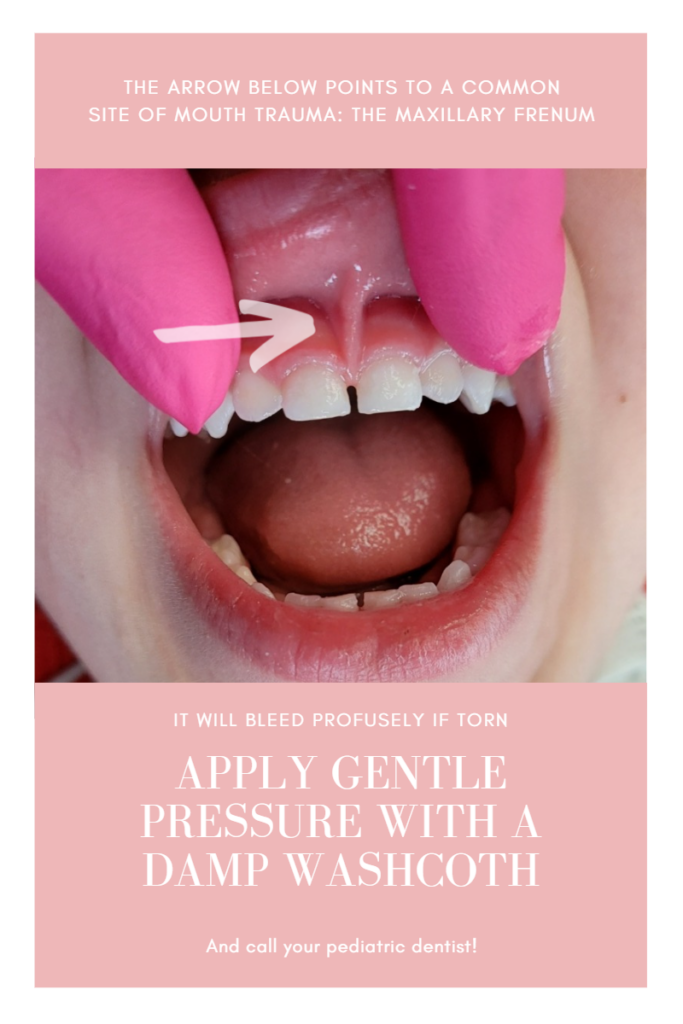Taylor McFarland DDS, MS – Board-Certified Pediatric Dentist and Mom
 It’s reported that 5% of all children will experience a traumatic dental injury for which they will seek treatment. For this reason, it is important to establish a dental home for every child so that management of these injuries is appropriate and swift. Often urgent care centers and ERs are unable to or unaware of how best to manage mouth injuries, and if no dentist is on call and you have not yet established a provider for your child, that can significantly delay their receipt of appropriate dental trauma management.
It’s reported that 5% of all children will experience a traumatic dental injury for which they will seek treatment. For this reason, it is important to establish a dental home for every child so that management of these injuries is appropriate and swift. Often urgent care centers and ERs are unable to or unaware of how best to manage mouth injuries, and if no dentist is on call and you have not yet established a provider for your child, that can significantly delay their receipt of appropriate dental trauma management.
The American Academy of Pediatric Dentistry recommends the establishment of a dental home occur by a child’s first birthday or within six months of their first tooth coming in, whichever is earlier. One of the primary reasons to do this is because the majority of mouth injuries occur between the ages of eighteen months and three years. When we consider that children are learning to move and coordinate their bodies during this timeframe, plus they’re top-heavy, it makes sense. They often stumble or fall and if they are in the proximity of something hard (coffee table, bathtub edge, bathtub faucet, windowsill, or fireplaces to name a few of the common locations) they can injure their mouth.
How do you avoid mouth injuries?
You won’t be able to avoid them entirely, so having a dental home established for evaluation and care is key. Sometimes young children bump heads with a sibling or trip over their own two feet, but you can help minimize the risk of mouth injuries by placing corner guards and faucet covers to make hard and/or sharp corners in your home less of a hazard. You can also practice awareness of common injury locations – like the bathtub ledge or faucet – and use good bathtime safety practices like having the child remain seated and not allowing them to walk around in the tub.
There are two particular mouth injuries I want to cover in-depth because both result in a lot of bleeding and can be quite scary for the caregivers. The first is a torn maxillary frenum. The frenum is a strip of tissue that connects the upper lip to the gums. When a young child falls, because this tissue is very prominent at young ages (don’t get me started on the overdiagnosis of lip ties – a frenum is normal anatomy), when a child falls and hits their upper lip that tissue ofter separates or “tears”. This tissue is highly vascularized and will bleed profusely, but all that is needed is gentle pressure with a damp washcloth. Contact your dentist to let them know about the injury, maybe even send a photo, and they will let you know if and when they want to see your child for a visit depending on the history and severity of the injury.
The second injury I’d like to cover is far more serious. It involves a blunt object forcibly meeting the back of the mouth. Think of a child walking with a hard object in their mouth – a straw, a spouted sippy cup, a teether tube, a toothbrush, a toy, a utensil – and then tripping. Injuries to the mouth range from minor, such as large painful ulcerations or scrapes across the tissue of the palate, to severe and life-threatening. The back of the throat contains many important vessels that can easily be nicked and lead to bleeding. There is also only a thin layer of tissue between the back of the throat and the brain stem. Some of these injuries are neurologically devastating, if not fatal. I encourage you as much as you are able to never allow a child to walk with something in their mouth – so toothbrushing should always be supervised and seated, as should straw drinking, eating with utensils, and really anything where a hard object is placed into the mouth. Should a severe injury mentioned above occur, a trip to the emergency room is warranted. You can contact your dentist from there if necessary to schedule follow-up care.
I hope this information was informative! To locate a pediatric dentist near you, search by zipcode using the American Academy of Pediatric Dentistry’s website or the American Board of Pediatric Dentistry’s website. If you have any questions, you can find Dr. McFarland on social media such as TikTok and Instagram as TheMamaDentist and on her website, themamadentist.com
Featured photo by S&B Vonlanthen on Unsplash.
